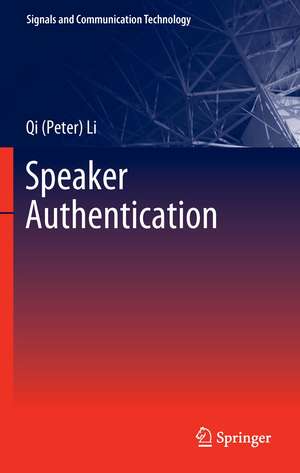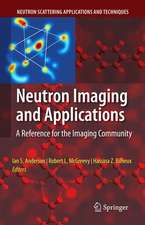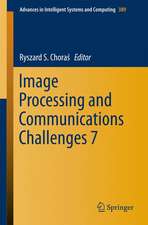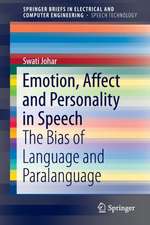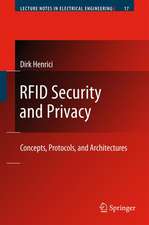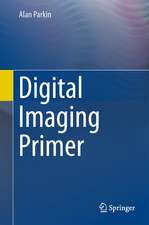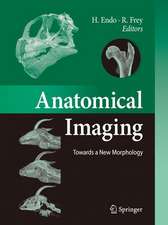Speaker Authentication: Signals and Communication Technology
Autor Qi (Peter) Lien Limba Engleză Paperback – 29 noi 2013
| Toate formatele și edițiile | Preț | Express |
|---|---|---|
| Paperback (1) | 942.94 lei 6-8 săpt. | |
| Springer Berlin, Heidelberg – 29 noi 2013 | 942.94 lei 6-8 săpt. | |
| Hardback (1) | 947.35 lei 6-8 săpt. | |
| Springer Berlin, Heidelberg – 2 oct 2011 | 947.35 lei 6-8 săpt. |
Din seria Signals and Communication Technology
- 18%
 Preț: 952.89 lei
Preț: 952.89 lei - 18%
 Preț: 1559.80 lei
Preț: 1559.80 lei - 17%
 Preț: 361.80 lei
Preț: 361.80 lei - 18%
 Preț: 811.61 lei
Preț: 811.61 lei - 15%
 Preț: 585.26 lei
Preț: 585.26 lei - 18%
 Preț: 727.97 lei
Preț: 727.97 lei - 15%
 Preț: 585.90 lei
Preț: 585.90 lei -
 Preț: 393.35 lei
Preț: 393.35 lei - 20%
 Preț: 1002.73 lei
Preț: 1002.73 lei - 15%
 Preț: 641.71 lei
Preț: 641.71 lei - 20%
 Preț: 338.92 lei
Preț: 338.92 lei - 18%
 Preț: 1579.66 lei
Preț: 1579.66 lei - 18%
 Preț: 896.08 lei
Preț: 896.08 lei - 18%
 Preț: 847.11 lei
Preț: 847.11 lei - 18%
 Preț: 1234.77 lei
Preț: 1234.77 lei - 18%
 Preț: 905.54 lei
Preț: 905.54 lei - 15%
 Preț: 646.43 lei
Preț: 646.43 lei - 20%
 Preț: 662.48 lei
Preț: 662.48 lei - 15%
 Preț: 641.20 lei
Preț: 641.20 lei - 18%
 Preț: 1847.84 lei
Preț: 1847.84 lei - 18%
 Preț: 946.24 lei
Preț: 946.24 lei - 18%
 Preț: 1241.10 lei
Preț: 1241.10 lei - 20%
 Preț: 649.43 lei
Preț: 649.43 lei - 20%
 Preț: 993.28 lei
Preț: 993.28 lei - 18%
 Preț: 940.57 lei
Preț: 940.57 lei - 18%
 Preț: 1389.30 lei
Preț: 1389.30 lei - 20%
 Preț: 1003.50 lei
Preț: 1003.50 lei - 18%
 Preț: 953.52 lei
Preț: 953.52 lei - 20%
 Preț: 1001.16 lei
Preț: 1001.16 lei - 18%
 Preț: 1415.36 lei
Preț: 1415.36 lei - 15%
 Preț: 653.33 lei
Preț: 653.33 lei - 15%
 Preț: 645.60 lei
Preț: 645.60 lei - 15%
 Preț: 637.28 lei
Preț: 637.28 lei - 18%
 Preț: 948.79 lei
Preț: 948.79 lei - 18%
 Preț: 945.62 lei
Preț: 945.62 lei - 18%
 Preț: 836.36 lei
Preț: 836.36 lei - 18%
 Preț: 1225.46 lei
Preț: 1225.46 lei - 15%
 Preț: 635.01 lei
Preț: 635.01 lei - 15%
 Preț: 639.25 lei
Preț: 639.25 lei - 15%
 Preț: 646.30 lei
Preț: 646.30 lei - 15%
 Preț: 639.25 lei
Preț: 639.25 lei - 15%
 Preț: 712.36 lei
Preț: 712.36 lei - 20%
 Preț: 1006.12 lei
Preț: 1006.12 lei - 18%
 Preț: 970.56 lei
Preț: 970.56 lei
Preț: 942.94 lei
Preț vechi: 1149.93 lei
-18% Nou
Puncte Express: 1414
Preț estimativ în valută:
180.45€ • 195.95$ • 151.58£
180.45€ • 195.95$ • 151.58£
Carte tipărită la comandă
Livrare economică 23 aprilie-07 mai
Preluare comenzi: 021 569.72.76
Specificații
ISBN-13: 9783642270888
ISBN-10: 3642270883
Pagini: 264
Ilustrații: XXVI, 238 p.
Dimensiuni: 155 x 235 x 14 mm
Greutate: 0.37 kg
Ediția:2012
Editura: Springer Berlin, Heidelberg
Colecția Springer
Seria Signals and Communication Technology
Locul publicării:Berlin, Heidelberg, Germany
ISBN-10: 3642270883
Pagini: 264
Ilustrații: XXVI, 238 p.
Dimensiuni: 155 x 235 x 14 mm
Greutate: 0.37 kg
Ediția:2012
Editura: Springer Berlin, Heidelberg
Colecția Springer
Seria Signals and Communication Technology
Locul publicării:Berlin, Heidelberg, Germany
Public țintă
ResearchCuprins
What is speaker authentication?.- Statistical approaches to detection, identification and verification.- Representations of speaker characteristics for authentication purposes.- Robust endpoint detection and feature extraction.- Statistical models for dynamic pattern recognition.- Fundamental approaches to speaker verification and identification.-Discriminative training.- Relation among discriminative training objectives.- Fast discriminative training algorithms for real application.- Fast and detection-based decoding for a large group of users.- Verbal information verification.- Sequential speaker authentication.- Sequential multi-modality biometric tests. Microphone array for speaker authentication and speech recognition.
Recenzii
From the reviews:
“The book covers the latest research advances within the domain of speaker authentication. … Every chapter is standalone and therefore the reader can choose and fully examine only his/her theme of interest. All the theoretical findings are tested on real-world applications and results demonstrate the potential of the presented approaches; the book is thus useful both for teaching and research, as well as for industry.” (Catalin Stoean, Zentralblatt MATH, Vol. 1233, 2012)
“This book is, among other things, proof that to be great, a technical reference does not necessarily need to be huge and ‘all inclusive.’ … techniques described, especially those for pattern recognition, are general enough to be used in almost any other area where there is a need for machine classification. … This is a superb technical book, which will also be useful outside of the speech processing area. I highly recommend it for graduate studies or as a specialized reference for those in industry.” (Vladimir Botchev, ACM Computing Reviews, June, 2012)
“The book covers the latest research advances within the domain of speaker authentication. … Every chapter is standalone and therefore the reader can choose and fully examine only his/her theme of interest. All the theoretical findings are tested on real-world applications and results demonstrate the potential of the presented approaches; the book is thus useful both for teaching and research, as well as for industry.” (Catalin Stoean, Zentralblatt MATH, Vol. 1233, 2012)
“This book is, among other things, proof that to be great, a technical reference does not necessarily need to be huge and ‘all inclusive.’ … techniques described, especially those for pattern recognition, are general enough to be used in almost any other area where there is a need for machine classification. … This is a superb technical book, which will also be useful outside of the speech processing area. I highly recommend it for graduate studies or as a specialized reference for those in industry.” (Vladimir Botchev, ACM Computing Reviews, June, 2012)
Textul de pe ultima copertă
This book focuses on use of voice as a biometric measure for personal authentication. In particular, "Speaker Recognition" covers two approaches in speaker authentication: speaker verification (SV) and verbal information verification (VIV). The SV approach attempts to verify a speaker’s identity based on his/her voice characteristics while the VIV approach validates a speaker’s identity through verification of the content of his/her utterance(s). SV and VIV can be combined for new applications. This is still a new research topic with significant potential applications. The book provides with a broad overview of the recent advances in speaker authentication while giving enough attention to advanced and useful algorithms and techniques. It also provides a step by step introduction to the current state of the speaker authentication technology, from the fundamental concepts to advanced algorithms. We will also present major design methodologies and share our experience in developing real and successful speaker authentication systems. Advanced and useful topics and algorithms are selected with real design examples and evaluation results. Special attention is given to the topics related to improving overall system robustness and performances, such as robust endpoint detection, fast discriminative training theory and algorithms, detection-based decoding, sequential authentication, etc. For example, the sequential authentication was developed based on statistical sequential testing theory. By adding enough subtests, a speaker authentication system can achieve any accuracy requirement. The procedure of designing the sequential authentication will be presented. For any presented technique, we will provide experimental results to validate the usefulness. We will also highlight the important developments in academia, government, and industry, and outline a few open issues. As the methodologies developed in speaker authentication span several diverse fields, the tutorialbook provides an introductory forum for a broad spectrum of researchers and developers from different areas to acquire the knowledge and skills to engage in the interdisciplinary fields of user authentication, biometrics, speech and speaker recognition, multimedia, and dynamic pattern recognition.
Caracteristici
First book in speaker recognition/authentication area Provides a step by step introduction to the current state of the speaker authentication technology Advanced and useful topics and algorithms are selected with real design examples and evaluation results Includes supplementary material: sn.pub/extras
